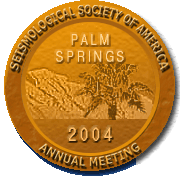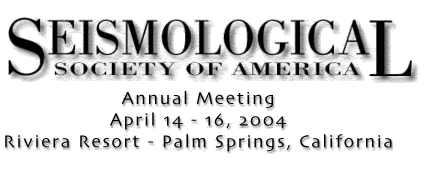

|
PROGRAM: Special Session Summaries The San Andreas Fault System: Past, Present, Future Conveners: Susan Hough (hough@usgs.gov) and Tom Rockwell (trockwel@cox.net) The San Andreas fault system is among the most intensively investigated continental transform faults in the world. It also provides a natural laboratory to address key remaining questions associated with the structure of continental fault systems and the earthquakes that occur on them. These earthquakes pose a substantial hazard to the growing urban regions of southern California, which must be understood to mitigate risk. This session will highlight results from a broad range of investigations, including the geology, geodesy, seismology, and paleoseismology of the San Andreas fault system. We also welcome presentations on other large continental transform faults, and recent large earthquakes on them, in other regions. Plate Boundary Deformation WorldwideConveners: Ken Hudnut (hudnut@usgs.gov) and Egill Hauksson (hauksson@caltech.edu) This session explores kinematic and dynamic descriptions, models and interpretations of deformation at plate boundaries of all kinds from all around the world. Plate boundary deformation continues to fascinate and engage many researchers. Over a wide range of temporal and spatial scales, earth's lithosphere displays complex behavior that defies simple explanations. Such complexity presents a great challenge, both to our observational capabilities and to our imaginations. With new technologies such as precise GPS having been globally available for more than fifteen years, what has been discovered? What remains to be learned, and how would an improved understanding make a difference? 10 Years After Northridge: A Retrospective and Call to ActionConveners: Lisa Grant (lgrant@uci.edu) and Mark Benthien (benthien@usc.edu) After a decade, the Northridge Earthquake still holds the dubious distinction of being the most expensive natural disaster in U.S. history and therefore offers an unparalleled opportunity for learning about the science and mitigation of earthquake hazard in urban areas. This multi-disciplinary session examines the lessons and implications of the 1994 Northridge earthquake. Submissions are encouraged on scientific, engineering and social topics related directly or indirectly to the Northridge earthquake, including topics focused on urban seismic hazards, blind faults, ground motion, risk assessment, and hazard mitigation. Rupture Dynamics and Strong MotionConveners: Paul Somerville (Paul_Somerville@URSCorp.com) and Ralph Archuleta (ralph@crustal.ucsb.edu) We are soliciting papers that link strong ground motion and rupture dynamics. Dynamic simulations of earthquakes may provide new insights into the nature of strong ground motion. Possible topics include the influence of the hanging wall, buried ruptures, heterogeneous friction, pore pressure, supershear rupture velocity, and pulse vs crack propagation. Papers that show comparisons of simulated strong motion with data, and that use recorded ground motions to constrain rupture dynamics parameters, are particularly encouraged. PSHA at Low Probabilities, the Ergodic Assumption, Precarious Rocks, and Shattered RocksConvener: Jim Brune (brune@seismo.unr.edu) PSHA makes statistical assumptions which are very questionable when extended to maximum (but low probability) ground motions which cold occur over very long periods of time (important for design of critical structures such as nuclear power plants and the proposed nuclear waste repository at Yucca Mountain). The short historical data-base for instrumental recordings is not sufficient to resolve the uncertainties. This special session will consider possible statistical modifications of PSHA, possible physical bases for truncating statistical distributions, and constraints provided by precarious rocks and shattered rocks, which apply to time periods of thousands of years and millions of years, respectively. Structure of Active Fault SystemsConveners: John Vidale and Egill Hauksson Faults play a key role in plate tectonics and earthquake hazards as the loci of deformation in the crust. They are undergoing increasing scrutiny by seismology, field mapping, rock mechanical experiments and numerical simulations to understand their rheological properties and evolution through the earthquake cycle. The most advanced studies investigate the system-level architecture and behavior of fault networks to improve understanding of the cooperative interactions that take place over a wide range of scales. This session welcomes papers that bring observations, theory, prejudice, and facts closer together on understanding fault systems. EarthScopeConveners: Tom Henyey (henyey@usc.edu) and Tom Jordan (tjordan@usc.edu) EarthScope is a bold new program of the National Science Foundation that will allow scientists to apply modern observational, analytical and information technologies to investigate the structure and evolution of the North American continent. A principal objective of the program, particularly in its early stages, is to investigate the physical processes operating along the Pacific-North American plate boundary such as those controlling earthquakes and volcanoes. Although only recently funded, EarthScope activities have been underway for sometime. Facilities planning, pilot studies, education and outreach, and the identification of scientific targets have all been part of the pre-funded activities. This special session will entertain papers in these general areas as they relate EarthScope's investigation of the plate boundary of western U.S. Toward Physics-Based Earthquake-Rupture-Forecast ModelsConvener: Ned Field (field@usgs.gov) The earthquake-rupture forecast used in the U.S. National Seismic Hazard Maps assumes that each event is completely independent of all other events (a Poisson process). Perusal of recent geophysics literature, on the other hand, reveals a flood of publications on stress interaction and time-dependent earthquake effects. Furthermore, recent Working Groups on California Earthquake Probabilities (e.g., 1995 and 2002) have clearly revealed a lack of consensus on how to construct more physics-based forecasts, which explains in part why the national hazard maps still use a relatively simple model. Because consensus on a more physics-based approach is not likely anytime soon, the appropriate approach is to accommodate different viable models in seismic hazard analysis (SHA). This is not a merely academic exercise, as proper SHA requires that all viable models be included in the analysis (something we have yet to achieve). This session is intended to highlight some of the more advanced earthquake-rupture-forecast models currently under development, such as those of the so-called "RELM" working group in southern California (http://www.RELM.org). FIELD TRIPS Shattered Rocks and Precariously Balanced Rocks (Friday afternoon, 16 April 2004) Leaders: Jim Brune (brune@seismo.unr.edu) and Doug Yule (j.d.yule@csun.edu) We will observe the scarp of the San Gorgonio Pass thrust fault, and associated relatively undamaged foot-wall and intensely shattered hanging-wall crystalline rocks, evidence of strongly asymmetric ground motions. We will then observe precariously balanced rocks indicating low ground motions near a trans-tensional step-over in the San Jacinto fault. We will then proceed to half-way between the San Jacinto and Elsinore faults where spectacular precariously balanced rocks constrain the ground motion from numerous M~7 earthquakes. We will consider possible explanations of the discrepancy between the ground motion constraints and the 2% in 50 yr ground motions in the official hazard maps. San Andreas Fault Zone in the Indio and Mecca Hills, Southern California (Saturday, 17 April 2004)Leaders: Michel Rymer (mrymer@usgs.gov) and Tom Rockwell (trockwel@cox.net) Recent geological and geophysical studies of the San Andreas fault zone in the Indio and Mecca Hills indicate a complex zone of faulting and permanent off-fault deformation. These studies provide important insights into fault-zone processes and geologic hazards. This field trip will explain many of these new studies in two field stops. The first stop, in the Indio Hills, will present the Thousand Palms paleoseismic site, geologic and seismic-reflection evidence of rapid horizontal- and vertical-axis block rotations, and geomorphic expression of echelon steps in the trace of the San Andreas fault. The second stop, in the Mecca Hills, will feature microgeomorphic expression of aseismic creep and triggered slip, field exposures of a fault duplex developed at the base of the Bishop ash bed, and outcrops of mudstone and sandstone incorporated into the San Andreas fault zone. Summaries of the geologic setting will present evidence that part of the structural complexity in the Indio and Mecca Hills is due to deformation at the southern end of the eastern California shear zone. |
Home |
Contacts |
Meeting Info |
Sessions |
Posters |
Exhibitors |
Schedule |
Travel |
Downloads
